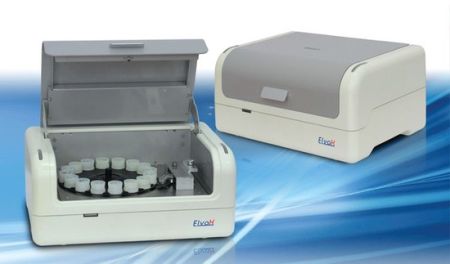XRD - diffractometer PANanalytical Empyrean
(PANanalytical, Holland)
diffractometer Empyrean, PC controlled, Cu tube, goniometr, PC for data collection and evaluation with yearly updated database PDF-4+, PDF-4/Organics.Standard Bragg-Brentano set-up for XRD analysis - automatic variable slits, sample changer for 45 samples, 1D detector PIXCEL. Measurement range 0.6-140° - „beam knife“.Set-up for measurement of thin layers with thickness below 200nm – focusing mirror, parallel plate collimator 0.18degree + sealed 0D detektor.
More details: https://www.malvernpanalytical.com/en/products/product-range/empyrean-range/empyrean
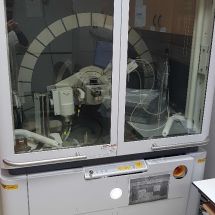
High temperature chamber for X-Ray diffractometer (XRD)
XRD - diffractometer Bruker AXS D8
(Bruker, Germany)diffractometer Bruker D8, PC controlled, Co(Cu or Mo tube), goniometr, automatic variable slits, rotational sample stage, sample changer for 7 samples, 1D LynxEye detector, yearly updated database PDF-4+, PDF-4/Organics, high

XRD - diffractometer PANanalytical X´Pert PRO
(PANanalytical, Holland)diffractometer X´Pert PRO, PC controlled, Co tube, goniometr, automatic variable slits, sample changer for 15 samples, 1D XCelerator detector, yearly updated database PDF-4+, PDF-4/Organics. Measurement range 0.6-140° - „beam knife“.

XRD - diffractometer PANanalytical X'Pert3 Powder
(PANanalytical, Holland)
diffractometer X´Pert3 Powder, PC controlled, Cu tube, goniometr, automatic variable slits, sample changer for 15 samples, 1D detector PIXCEL, yearly updated database PDF-4+, PDF-4/Organics. Measurement range 0.6-140° - „beam knife“.
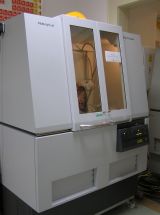
microXRD – microdiffraction and texture system D8 Discover with the 2D Vantech detector
(Bruker, Germany)Microdiffraction system D8 Discover, PCr controlled, Co tube, goniometr, parallel polycapilary optic POLYCAP with primary diametr beam of 4mm, 5 long UBC collimators – diameters 0.1, 0.3, 0.5, 1 and 2mm. Compact motorized XYZ stage – load capacity 1kg, maximum height of sample 42mm, X,Y,Z –range -25mm. X-ray powder diffraction can be employed with the aim to measure powder patterns from spots of a minimum size 100 x 100 μm. The system is capable to collect Debye-Scherrer frames convertible into a standard 1D powder pattern.

XRF - spectrometer ARL 9400 XP
(Thermo ARL, Switzerland)Fully automatic sequantial XRF spectrometer for qualitative and quantitative element analysis up to 83 elements of periodic table (B-C O-U) in the range from ppm to 100%. Possible samples – solid materials, powders, thin films and fluids. Rh tube, 4kW generator, 4 collimators, 6 crystals (AX 20, TLAP, PET, Ge 111, LiF 200, LiF 220), 2 detectors – proporcional and scintilation. Analysis using calibration curve done with software Winxrf. Standardless analysis done with program Uniquant 4.
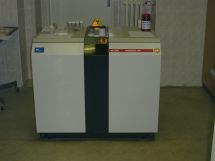
XRF - spectrometer Axios
(PANanalytical, Holland)Fully automatic sequantial XRF spectrometer for qualitative and quantitative element analysis up to 87 elements of periodic table (B-U) in the range from ppm to 100%. Possible samples – solid materials, powders, thin films and fluids. Rh tube, 4kW generator, 3 collimators, 8 crystals (PX1, PX4a, PX5, PX7, PE002, Ge 111, LiF 200, LiF 220), 2 detectors – proporcional and scintilation. Analysis using calibration curve done with software SuperQ 5.0. Standardless analysis done with program Omnian.
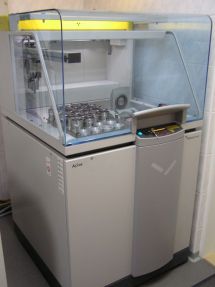
• XRF - spectrometer Performix – spot analysis(1.5mm) and mapping – circle with diameter 20mm
(Thermo ARL, Switzerland)Fully automatic sequantial XRF spectrometer for qualitative and quantitative element analysis up to 83 elements of periodic table(Be-B O-U) in the range from ppm to 100%. Possible samples – solid materials, powders, thin films and fluids. Rh tube, 4kW generator, 4 collimators, 6 crystals (AXBeB, AX03, PET, Ge 111, LiF 200, LiF 220), 2 detectors – proporcional and scintilation. Analysis using calibration curve done with software Oxsas. Standardless analysis done with program Uniquant 5 integrated in Oxsas. Spot analysis from the 1.5mm spot.
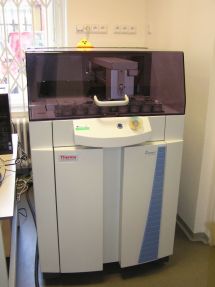
XRF - spectrometr ZSX Primus IV (Rigaku, Japonsko)
Fully automatic sequantial XRF spectrometer for qualitative, semiquantitative and quantitative element analysis up to 87 elements of periodic table (Be-U) in the range from ppm to 100%. Possible samples – solid materials, powders, thin films and fluids. Rh tube ABOVE SAMPLE=well pressed samples can be mesured without binder or foil (B-Mg measured easily and more accurately), 4kW generator, 3 collimators, 7 crystals (RX85-Be-B, RX61-C, RX40-N-O, RX26-F-Na-Mg, PET, Ge 111, LiF 200), 2 detectors – proporcional and scintilation. SEMIQUANTITATIVE standardless analysis performed with program SQX, QUANTITATIVE analysis using calibration curve performed with software SQX. More info: https://www.rigaku.com/products/wdxrf/primusiv

EDXRF portable spectrometr XL5
(Thermo)
is an instrument for a qualitative, semiquantitative and quantitative element analysis in the elemental range Mg-U and in a concentration range 0.01-100%, time 120s (chemical composition, shape and size of the sample are important).
XL5 can perform fast screening of present elements in concentration above 0.01% in time of 30s.
Measured spot is the circle with the diameter of 8mm, possibility to use mask with diameter of 3mm, worse detection limits and longer time.
Sample is measured in air and in principle may have whatever dimensions. It is possible to measure small samples( better not smaller than 3mm) or larger samples (X-ray safe are samples which fit in standard desk stand, Maxsize D19xW19xH11cm). Bigger saples can be measured if the safety rules are fulfilled.
XL5 is not able to perform sample analysis in the whole elemental range of Mg-U at the same time. It works with pre-prepared calibrations. XL5 detects and quantifies only the elements in calibrations. If the sample contains an element which is not in calibration (usually due to a poorly correctable overlap with elements in calibration), then this element is not detected. However, the presence of other elements in the sample can be verified by looking at the measured scans.
The spectrometer is equipped with calibrations General Metals (3,8mm), Precious Metals (3,8mm), Coating (8mm), Mining (3,8mm), Plastics (8mm), Soils(8mm),.
Calibrations include the following elements:
General Metals: Mg, Al, Si, P, S, Ti, V, Cr, Mn, Fe, Co, Ni, Cu, Zn, As, Se, Y, Zr, Nb, Mo, Pd, Ag, Cd, In, Sn, Sb, Hf, Ta, W, Re, Au, Hg, Pb, Bi
Precius Metals: Al, Ti, V, Cr, Mn, Fe, Co, Ni, Cu, Zn, Ga, Ge, Zr, Nb, Mo, Ru, Rh, Pd, Ag, Cd, In, Sn, W, Ir, Pt, Au, Pb
Coating: Mg, Al, Si, P, S, Ti, V, Cr, Mn, Fe, Co, Ni, Cu, Zn, As, Se, Y, Zr, Nb, Mo, Pd, Ag, Cd, In, Sn, Sb, Hf, Ta, W, Re, Au, Hg, Pb, Bi
Mining: Mg, Al, Si, P, S, Cl, K, Ca, Ti, V, Cr, Mn, Fe, Co, Ni, Cu, Zn, As, Se, Rb, Sr, Y, Zr, Nb, Mo, Pd, Ag, Cd, Sn, Sb, Ba, Hf, Ta, W, Re, Au, Hg, Pb, Bi, Th, U
Soil: S, K, Ca, Ti, V, Cr, Mn, Fe, Co, Ni, Cu, Zn, As, Se, Rb, Sr, Y, Zr, Mo, Pd, Ag, Cd, Sn, Sb, Te, Cs, Ba, W, Re, Au, Hg, Pb, Th, U
Plastics: Al, Cl, Ca, Ti, V, Cr, Mn, Fe, Co, Ni, Cu, Zn, As, Se, Br, Sr, Cd, Sn, Sb, Ba, Au, Hg, Pb, Bi
http://www.hukos.cz/spektrometr-xl5/
https://www.thermofisher.com/order/catalog/product/NITONXL5
Eagle III-Micro-EDXRF
Energy-dispersive X-ray microfluorescence system for point analysis from a point of about 50 microns in the Na-U range.
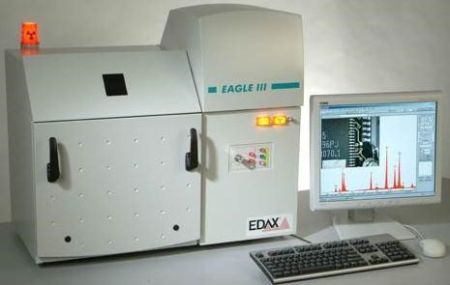
Detail information:
http://www.speciation.net/Database/Instruments/Edax-Inc/Eagle-III-Probe-;i1560
XRF – EDXRF spectrometr Elvax PRO
(Elvatech, Ukrajina)
ElvaX Pro is an energy-disperzive XRF spectrometr for qualitative, semiquantitative and quantitative elemental analysis of elements (Na-U) in range tens of ppm upto 100%. It is suitable for measurement of liquids (pH 1-14) and poorly pressable samples.
